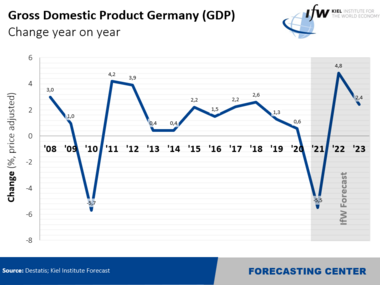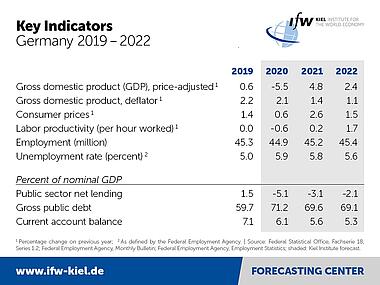News
Kiel Institute Economic Forecast: Economic recovery loses speed after quick rebound

Industries that are particularly dependent on social contacts, such as restaurants, tourism or the event industry, continue to be severely restricted in their business activities. According to Kiel Institute estimates these industries account for 6 percent of the German economy. Their capacity utilization rates will remain significantly lower for some time to come and they will only support the recovery when Corona related health protection measures are largely eliminated. The researchers expect this to happen gradually from spring 2021 onwards. Moreover, the economic damage caused by the Corona pandemic will continue to slow down the global economy for some time to come. "The crisis has put a particular strain on corporate equity positions, which is likely to dampen their investment activity worldwide for some time to come. The German economy, as a major supplier of machinery and equipment, is particularly sensitive to global investment activity. Also, travel restrictions hamper corporates to get in touch with customers which is an additional brake on new business," explains Stefan Kooths, head of forecasting at the Kiel Institute.
According to the researchers' assessment, the economy made a strong V-shaped recovery in the second and third quarters, which they attribute in part to catch-up effects in both industry and retail. "Although the German economy has already made up most of the slump from the lockdown phase, capacity utilization is still far from normal," said Kooths. For the third quarter, there are signs of a strong growth rate in gross domestic product (GDP) of 6.2 percent following minus 9.7 percent in the previous quarter; thereafter, the recovery will slow down. "All in all, the economic engine has successfully restarted, but it will run at subdued speed for some time to come. Economic output will not catch up to pre-crisis levels before the end of next year and will then still be three percent below the level that would have been possible without the Corona crisis.”


Although the current recovery has been faster than that following the global financial crisis in 2008/09, the corona crisis is leaving a clearer mark on the labor market: despite massive recourse to the short-time working scheme, an estimated 810,000 jobs have been lost - mainly in the restaurant trade and in the temporary employment sector. Without the corona recession, the number of unemployed would currently be an estimated 640,000 lower. However, the trough of the crisis seems to have been overcome, as labor market data have been pointing to a gradual increase in employment since the middle of the year. Still, it will probably take until the beginning of 2022 for the employment slump to be fully recovered. The unemployment rate is likely to be 5.9 percent this year and 5.8 percent next year.
As a result of the economic crash and the subsequent stimulus packages, the public budgets in 2020 are posting one of the largest deficits ever measured (5.1 percent in relation to GDP), following a surplus in 2019. Gross debt is expected to increase by almost EUR 300 billion (to reach in total a good 70 percent in relation to GDP).
In the countries of the Euro zone, which include Germany's most important export markets, the economy picked up again after the end of the lockdown that caused an unprecedented 15 percent drop in overall economic output. In the course of a strong recovery, almost two thirds of the decline in production should be made up in the third quarter. However, the recovery is likely to be much slower in the coming quarters. "Given the sharp rise in the number of infections in some member states, there is great uncertainty about the progress of the pandemic, especially in the coming winter. In addition, the legacy of the crisis in terms of damaged corporate balance sheets is a serious risk for the recovery," says Kooths. Unemployment figures have recently risen again in practically all member states, and this trend is likely to continue for the time being. Overall, GDP in the Euro area is expected to fall by 7.1 percent in the current year followed by growth rates of 5.3 percent in the coming year and 2.6 percent in 2022. Thus, the pre-crisis level will not be seen before 2022.
Worldwide, economic output fell by almost 10 percent in the first half of 2020. After a decline of 3 percent in the first quarter, global production slumped by around 7 percent in the second quarter. Meanwhile, the recovery has set in, with high growth rates expected in the third quarter, similar to the Chinese pattern in spring. Unlike there, however, production in most countries will remain well below pre-crisis levels. The situation is likely to normalize much more slowly, partly because significant parts of the economy will continue to suffer from Corona-related restrictions for some time to come. In the current year, global production (based on purchasing power parities) will decline by 3.6 percent. For 2021, the Kiel Institute expects a strong increase in production of 6.7 percent. However, the level of global production will remain well below the path that was expected at the beginning of the year for some time to come.
The researchers give a mixed evaluation of anti-crisis programs in Germany: The immediate crisis response such as government liquidity and equity capital support and the expansion of short-time work benefits were justified in order to temporarily maintain fundamentally healthy economic structures. But the longer state aid is in place, the more harmful are the side-effects. "The instruments should be gradually scaled back instead of prolonging them further and further. Otherwise they threaten to preserve inefficient economic structures," said Kooths. "Stimulus programs targeting households’ purchasing power, such as reduced value-added tax rates, hardly help companies and their employees, because extraordinarily high savings rates indicate that purchasing power has been dammed up anyway. Consumers are not lacking purchasing power, but the opportunity or willingness to spend their money. In addition, the crisis is a mixture of economic and structural developments, to which policymakers should react separately as unsuitable regulations additionally hamper economic activity.“
----
Notice: A prior version of this media release said, gross debt would increase by almost EUR 300 billion or 70 percent in relation to GDP. We corrected this error.
